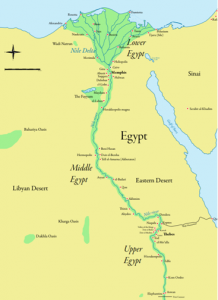Spotlight on a Mummified Crocodile from The Egypt Centre – by Warda Malik
Continuing our celebration of the Egypt Centre this week’s blog post is an edited version of a short piece of coursework originally submitted for the module ‘Egyptian Art and Archaeology’. For this assignment students were required to write an object biography for an exhibit in the Egypt Centre. Our author, Warda Malik, chose object W985 because crocodile mummies were neither something she had significantly come across before in lectures nor extensively read about.

Object W985, exact provenance unknown, is a mummified crocodile and is currently on display in the ‘House of Death’ in the Egypt Centre, Swansea. W985 was initially perceived to be a false mummy as votive animal mummies were often empty or only contained fragmented remains. Votive animals usually died a natural death; however, many were deliberately killed ahead of religious festivals, as could have been the case with W985. It is probable that these mummies were produced at times when there was a shortage of the appropriate animal required. W985 was X-rayed by St James vets in 2008, revealing that the mummy contained the remains of a baby crocodile approximately 18 inches long inside, however, they were commonly placed alongside fully-grown crocodile remains. Some examples of other x-rays undertaken on mummified crocodiles from the same context can be observed in the following images:
The Late Period (664-332BC) witnessed a dramatic rise of animal cults in ancient Egypt and may have been a result of artistic archaizing of the period. Unlike most of the Mediterranean, Egyptians did not regard animals as inferior to humans, and believed that they had a soul. In ancient Egypt, crocodiles were predominantly associated with Sobek ancient Egyptian crocodile deity) who was venerated from the Old Kingdom. His cult increased particularly during the Ptolemaic Period. Crocodiles’ natural habitat was largely the Nile and they were generally considered as the offspring of the annual inundation and acted as a symbol for the Nile’s fertility. Crocodiles tend to transport their young in their mouths to ensure safe travel, and additional baby crocodiles could symbolise a positive nurturing quality of an otherwise dangerous animal. Additionally, sacred animals were identified by their ‘special markings’ which acted as proof of their embodiment of specific gods. Therefore, it is likely that W985 was worshipped as a living incarnation of Sobek during its lifetime.

The most prominent cult centres of Sobek in ancient Egypt were Tebtunis, Kom Ombo and the Fayum region. The excavations of Tebtunis in the 1930’s unearthed many shallow graves, with crocodile remains found buried in the sand. A distinctive style of wrapping the crocodile remains in sheets of papyrus had been adopted and can be dated to the Greco-Roman period due to writing found on recycled papyri. From this, one can conclude that W985 is unlikely to have originated from the site of Tebtunis as it does not bear the characteristic papyrus wrapping found on other contemporary crocodile mummies.
Situated in Lower Egypt, near the Delta region, the area of Kom Ombo gained importance during the Ptolemaic Period due to its access to several trade routes and had a temple dedicated to both Sobek and Horus (Egyptian deity, associated with kingship). Living Crocodiles may have been kept in the vicinity due to the high regard given to Sobek. After its death, the crocodile would have been mummified and buried, achieving the state of immortality. During special religious festivals, mummified animals dedicated to specific deities were taken for procession and later buried in catacombs, sealed until the next celebration. It may be probable that W985 was initially found in such a cache, perhaps near the site of Kom Ombo rather than Tebtunis or the Fayum region as simpler burials of shallow graves were more common in those areas.
